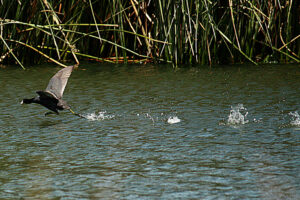Hey, What’s The Bird With The Big Feet?

“Hey, What’s The Bird With The Big Feet?” Many years ago, I was a staff biologist at a museum in Ohio and we had several live animals on exhibit. One such animal was a medium sized black bird with huge feet and these feet sparked the question from many school kids. When I said, “That bird is a Coot.”, I don’t think they took me seriously. I don’t blame them. The bird is not a great testament to aerodynamic design, nor is it colorful (it is black). So, one does ask, “Why the Coot?”. Did God just have a bad day?
Let’s start with the basics: birds fly unless it is an Ostrich. Coots can fly for short for short distances, but they have to run across the water for almost as far as they can fly just to get to take-off speed. Most ducks seem to be helicopters as they go almost vertically. But not Coots.
Most ducks “talk” with a recognizable quack. But not Coots. (BTW, Coots are not ducks) They just grunt. Maybe they just don’t have anything good to say. But they grunt almost constantly as they paddle along. It is thought that Coots use their grunts and clicks to communicate. If so, then they must have a “language of sorts, but it seems that this has not attracted the attention of serious ornithologists.
So, what do Coots eat? They eat the vegetation along the edges of ponds. One estimate from Back Bay, Virginia, suggested that the local coot population ate 216 tons (in dry weight) of vegetation per winter. Most of this food is just under the surface. Actually, they walk on their dinner. But they do have those enormous feet which keep them from sinking into it.
The real high point of the Coot story is that they are very common and are almost always in motion which makes them good subjects for the casual birder on the shore.
Learn more about The American Coot here: American Coot Overview, All About Birds, Cornell Lab of Ornithology